- Region
- Águilas
- Alhama de Murcia
- Jumilla
- Lorca
- Los Alcázares
- Mazarrón
- San Javier
-
ALL AREAS & TOWNS
- AREAS
- SOUTH WEST
- MAR MENOR
- MURCIA CITY & CENTRAL
- NORTH & NORTH WEST
- TOWNS
- Abanilla
- Abarán
- Aguilas
- Alamillo
- Alcantarilla
- Aledo
- Alhama de Murcia
- Archena
- Balsicas
- Blanca
- Bolnuevo
- Bullas
- Cañadas del Romero
- Cabo de Palos
- Calasparra
- Camping Bolnuevo
- Campo De Ricote
- Camposol
- Canada De La Lena
- Caravaca de la Cruz
- Cartagena
- Cehegin
- Ceuti
- Cieza
- Condado de Alhama
- Corvera
- Costa Cálida
- Cuevas De Almanzora
- Cuevas de Reyllo
- El Carmoli
- El Mojon
- El Molino (Puerto Lumbreras)
- El Pareton / Cantareros
- El Raso
- El Valle Golf Resort
- Fortuna
- Fuente Alamo
- Hacienda del Alamo Golf Resort
- Hacienda Riquelme Golf Resort
- Isla Plana
- Islas Menores & Mar de Cristal
- Jumilla
- La Azohia
- La Charca
- La Manga Club
- La Manga del Mar Menor
- La Pinilla
- La Puebla
- La Torre
- La Torre Golf Resort
- La Unión
- Las Palas
- Las Ramblas
- Las Ramblas Golf
- Las Torres de Cotillas
- Leiva
- Librilla
- Lo Pagan
- Lo Santiago
- Lorca
- Lorquí
- Los Alcázares
- Los Balcones
- Los Belones
- Los Canovas
- Los Nietos
- Los Perez (Tallante)
- Los Urrutias
- Los Ventorrillos
- Mar De Cristal
- Mar Menor
- Mar Menor Golf Resort
- Mazarrón
- Mazarrón Country Club
- Molina de Segura
- Moratalla
- Mula
- Murcia City
- Murcia Property
- Pareton
- Peraleja Golf Resort
- Perin
- Pilar de la Horadada
- Pinar de Campoverde
- Pinoso
- Playa Honda
- Playa Honda / Playa Paraíso
- Pliego
- Portmán
- Pozo Estrecho
- Puerto de Mazarrón
- Puerto Lumbreras
- Puntas De Calnegre
- Region of Murcia
- Ricote
- Roda Golf Resort
- Roldan
- Roldan and Lo Ferro
- San Javier
- San Pedro del Pinatar
- Santiago de la Ribera
- Sierra Espuña
- Sucina
- Tallante
- Terrazas de la Torre Golf Resort
- Torre Pacheco
- Totana
- What's On Weekly Bulletin
- Yecla


- EDITIONS:
 Spanish News Today
Spanish News Today
 Alicante Today
Alicante Today
 Andalucia Today
Andalucia Today
What to visit in Cartagena
Main tourist attractions Cartagena
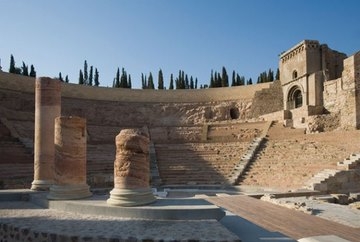 Cartagena is a city steeped in history and has many fascinating locations to visit.
Cartagena is a city steeped in history and has many fascinating locations to visit.
These are the main attractions, although there are plenty of buildings and monuments of lesser importance which also make time spent exploring the City an enjoyable experience.
If planning to spend time in Cartagena, it may well be worth reading the history of Cartagena first, as it helps to explain some of the cultures which inhabited this area and to appreciate the scale of the Roman city which once stood in this location.
Click for history of Cartagena: Click History of Cartagena
ARQUA
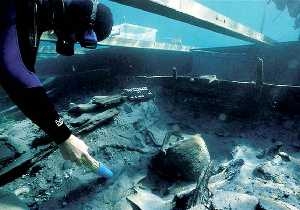 This is the national Museum of Subaquatic Archaeology and is located in the Muelle Alfonso XII, the main portside area of Cartagena. Dedicated to the practise of underwater archaeology, this Museum holds an interesting collection of artefacts recovered from subaquatic excavations off the Murcian coast, as well as a number of interesting interactive displays which demonstrate the processes used by archaeologists. The ARQUA also holds a replica of Mazarrón 2, the important Phoenician boat recovered off the Mazarrón coastline.
This is the national Museum of Subaquatic Archaeology and is located in the Muelle Alfonso XII, the main portside area of Cartagena. Dedicated to the practise of underwater archaeology, this Museum holds an interesting collection of artefacts recovered from subaquatic excavations off the Murcian coast, as well as a number of interesting interactive displays which demonstrate the processes used by archaeologists. The ARQUA also holds a replica of Mazarrón 2, the important Phoenician boat recovered off the Mazarrón coastline.
Click for ARQUA.
RomanTheatre Museum
 The Museo Teatro Romano is the most important Roman site in Cartagena. This 6,000 seater auditorium was built at the zenith of Roman power, when Cartagenawas a busy and important port, and has survived virtually intact. Visitors follow an interesting route via the artefacts recovered from the excavations, and pass beneath the streets to emerge into the theatre itself. This is located very close to the port area and is the main location to visit if spending just a few hours in Cartagena.
The Museo Teatro Romano is the most important Roman site in Cartagena. This 6,000 seater auditorium was built at the zenith of Roman power, when Cartagenawas a busy and important port, and has survived virtually intact. Visitors follow an interesting route via the artefacts recovered from the excavations, and pass beneath the streets to emerge into the theatre itself. This is located very close to the port area and is the main location to visit if spending just a few hours in Cartagena.
Click Museo Teatro Romano.
The House of Fortune, La Casa de Fortuna
This is an intact Roman dwelling, located beneath the streets of Cartagena. Visitors enter through the front door, from the original Roman street, and are provided with an intimate glimpse inside the domestic life of a typical Roman family living here over 2000 years ago.
Click Casa de Fortuna
Castillo de la Concepción and Panoramic Lift.
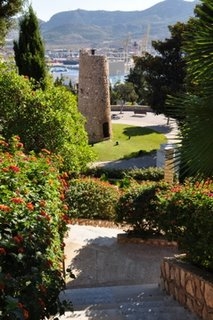 The Castillo de la Concepción was built in the 13th century, on the remains of former defensive buildings and occupies an important strategic position overlooking the City. It houses an interpretation centre which tracks the course of Cartagenas history and has a top level panoramic viewing point of the city. It is accessed via the panoramic lift, which climbs a distance of 45 metres in just a few seconds, enabling visitors to then wend their way down through the Parque Torres to another excellent viewing point, and down to the City below.
The Castillo de la Concepción was built in the 13th century, on the remains of former defensive buildings and occupies an important strategic position overlooking the City. It houses an interpretation centre which tracks the course of Cartagenas history and has a top level panoramic viewing point of the city. It is accessed via the panoramic lift, which climbs a distance of 45 metres in just a few seconds, enabling visitors to then wend their way down through the Parque Torres to another excellent viewing point, and down to the City below.
Click for Panoramic lift and Castillo de la Concepción
Augusteum
The Augusteum
This building, the Augusteum, was a combination of educational college (collegium) and a temple dedicated to the worship of the divinity of the Emperor Augustus. It has an interesting display about the function of the Roman forum ( in spanish) and a video showing how the building would formerly have appeared.
Click Augusteum.
MURAM
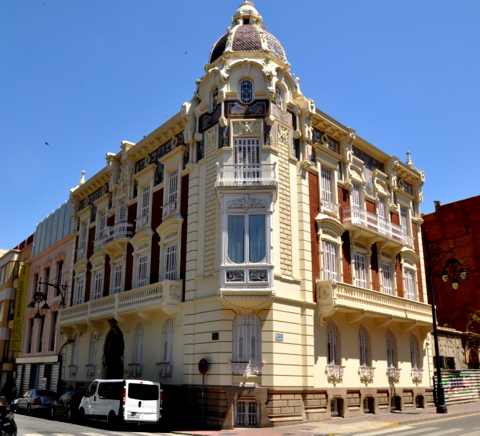 The Regional Museum of Modern Art.
The Regional Museum of Modern Art.
The Museum houses an extensive collection of modern art, as well as hosting temporary exhibitions.
Click MURAM.
Punic Wall Interpretation centre
This is the location of one of the two municipal tourist offices and houses the remains of the original punic wall which surrounded the city, as well as a crypt which dates from nearly 1800 years later and is a centre dedicated to the Pre-roman, Punic, period of Carthaginian history.
Click Punic Wall Interpretation Centre
Municipal Archaeological Museum
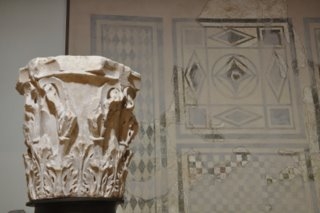 This is located on the outskirts of the city and is a fascinating place to visit as its actually constructed around the archaeological site of a burial necropolis which was in use for approximately 400 years from the 3rd to the 7th Century.
This is located on the outskirts of the city and is a fascinating place to visit as its actually constructed around the archaeological site of a burial necropolis which was in use for approximately 400 years from the 3rd to the 7th Century.
It covers a 700 square metre area and occupied the western bank of an ancient lagoon which constituted the northern boundary of the city, but which has now been totally absorbed into the urban landscape. It contains a collection of artefacts recovered from all the important sites discovered in the Cartagenamunicipality and is a good place in which to piece together the history of the city.
Click Municipal Archaeological Museum
The District of the Roman forum, The Molinete.
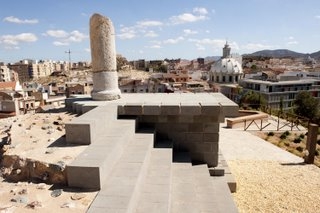 This is a new attraction, and opened Easter 2012.The park is an extensive public park, and at its foot lie the remains of a whole block of the old Roman city. It houses the atrium building where religious banquets were held, as well as a thermal bath complex, accessed via a colonnaded courtyard, known as a “peristyle”.
This is a new attraction, and opened Easter 2012.The park is an extensive public park, and at its foot lie the remains of a whole block of the old Roman city. It houses the atrium building where religious banquets were held, as well as a thermal bath complex, accessed via a colonnaded courtyard, known as a “peristyle”.
The visit continues with the “Decumanus”, a road orientated east-west in which there are more remains of the thermal bath complex.
Click for El Molinete
Military Locations within CartagenaCity:
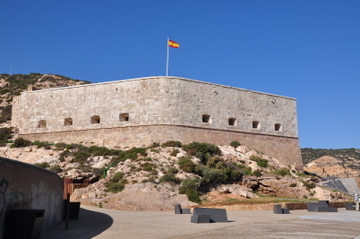 The Fuerte de Navidad
The Fuerte de Navidad
This military fort guards the entrance to the natural harbourof Cartagena. It can be accessed by car, being about a 5 kilometre drive from the centre of Cartagena, or from the Muelle Alfonso XII, the main waterfront of Cartagena, via the Barco turístico, the tourist boat.
Click for Fuerte de Navidad
The Military Museum, Cartagena City
 This museum contains a lot of the weaponry which was used throughout Cartagenas history of defence and a large amount of military memorabilia which was in use at the time of the Plan de Defensa 1926 installations.
This museum contains a lot of the weaponry which was used throughout Cartagenas history of defence and a large amount of military memorabilia which was in use at the time of the Plan de Defensa 1926 installations.
It is a fascinating place for anyone with an interest in military history to visit.
Click for Military Museum
The Civil War Refuge and Museum
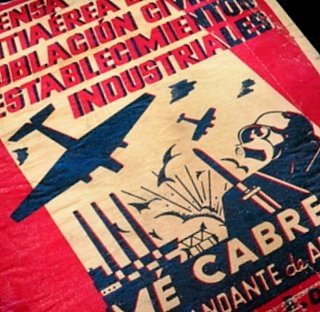 Its hard to believe how heavily Cartagena was punished for its loyalties during the Civil War and how much of it was destroyed in the heavy bombings which attacked the arsenal and fleet. This little museum is a fascinating journey into this time, made more poignant by the narratives which describe the experiences of people who lived through this local history. Bombs are still dug up in the streets, and discovered by divers exploring the coastline, and haunting shells of once magnificent buildings are still to be seen in the old streets today.
Its hard to believe how heavily Cartagena was punished for its loyalties during the Civil War and how much of it was destroyed in the heavy bombings which attacked the arsenal and fleet. This little museum is a fascinating journey into this time, made more poignant by the narratives which describe the experiences of people who lived through this local history. Bombs are still dug up in the streets, and discovered by divers exploring the coastline, and haunting shells of once magnificent buildings are still to be seen in the old streets today.
Click here to read full report about the Civil War Museum, Cartagena
Museo Naval
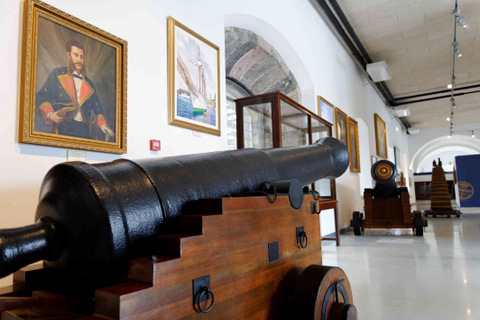 The Naval Museum relocated to the waterside of Cartagena in 2012 and is an interesting and well laid out Museum which displays some of the many artefacts related to Cartagena´s naval history. Display boards are in English and the collection has many fascinating exhibits covering shipbuilding, munitions, navigation, uniforms and flags, submarines and naval health.
The Naval Museum relocated to the waterside of Cartagena in 2012 and is an interesting and well laid out Museum which displays some of the many artefacts related to Cartagena´s naval history. Display boards are in English and the collection has many fascinating exhibits covering shipbuilding, munitions, navigation, uniforms and flags, submarines and naval health.
Click here for full information, Museo Naval Cartagena
Military Locations outside of main city area:(car required from Cartagena central)
 The Batteries of Castillitos and El Jorel at Cabo Tinoso
The Batteries of Castillitos and El Jorel at Cabo Tinoso
44 elements covered every angle of attackand batteries were constructed in a ring which encircled Cartagenaand out along the coast as part of the Plan de Defensa of 1926.
The location at Cabo Tinoso was chosen because of its strategic location, 218 metres above the sea on a rocky cliff top with easily defendable access, and Vickers guns, made in the UK, which were the best in the world for anti-shipping defence at this time, were situated at this point, giving a35km firing range.
There are 2 different batteries at Cabo Tinoso, La bateria del Jorel, which houses three 1923 model Vickers 152.4mm, 45 calibre anti-shipping guns, and the Bateria de Castillitos which has the enormous Vickers 381mm guns still in place, measuring 17 metres in length, which could fire a projectile weighing a ton over a distance of 35 km
Part of the excitement in visiting the batteries is that these enormous guns are still in situ, bar one of the Vickers 152.4mm guns which was dismantled and removed to Almeria during the 1936-1939 Spanish Civil war
Click hereCastillitos
The Batteries of Cenizas and Negrete
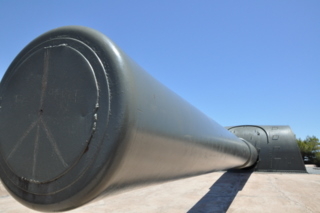 Located on the edge of Portman bay, just behind the La Manga Club, these 2 batteries were part of the 1926 Plan de Defensa and held the second pair of Vickers 381mm guns, massively powerful weapons which could fire a one ton projectile for nearly 35km. The 2 guns are still in place, set amidst the natural beauty of the Cenizas natural park. They are accessed only on foot via the military road which was built to haul the guns up their hilltop location, a 40 minute walk. The negrete anti aircraft battery is just a short distance from the main Vickers emplacement and there are fantastic views, as well as the enjoyable spectacle of the guns in situ
Located on the edge of Portman bay, just behind the La Manga Club, these 2 batteries were part of the 1926 Plan de Defensa and held the second pair of Vickers 381mm guns, massively powerful weapons which could fire a one ton projectile for nearly 35km. The 2 guns are still in place, set amidst the natural beauty of the Cenizas natural park. They are accessed only on foot via the military road which was built to haul the guns up their hilltop location, a 40 minute walk. The negrete anti aircraft battery is just a short distance from the main Vickers emplacement and there are fantastic views, as well as the enjoyable spectacle of the guns in situ
Click here to read the full report about the Batteries of Cenizas and Negrete





































